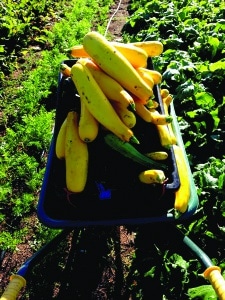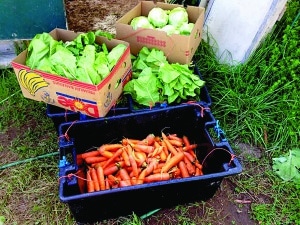Some Mount Allison students will soon find themselves responsible for financing, managing, and farming Mt. A’s farm.
Located about a 15-minute’s walk from campus, the 22-acre parcel of land sits between York Street and King Street. The words “Mount Allison Farm” peel off the eleven by fourteen inch sign that marks the York Street entrance. The dirt driveway that winds up the hill to the farm’s parking lot is already easy enough to miss.
The upper field is a 4-acre space, and a 1.5-acre section within the upper field has been the main target for soil enrichment and investment by the university. It’s this plot that the student farmers will be using to try and turn a profit during this growing season.
The farm began operating in 2011 under the guidance of Michelle Strain, Mt. A’s director of administrative services, and ran for two years on a model that saw the university take financial responsibility for providing the cash investments into planting and maintenance, as well as paying the student farmers through the university payroll system.
Compensation ranged from $14 an hour to the senior farmer student, and $11 to the farm assistant. Both were paid through the university’s payroll system.
In 2011 and 2012, there were potatoes grown in the upper field and organic vegetables in the lower one.
In 2011 alone, the farm produced 30,000 pounds of potatoes. A significant portion of the harvest went to Jennings Meal Hall, which purchased the vegetables and incorporated them into the other offerings in the rotation.
The farm also offered U-picks for Mt. A students that proved popular with those living off-campus.
But the farm was losing money. After running deficits of approximately $11,000 a year in 2011 and 2012, the farm stayed closed for the 2013 season, and went a year without a harvest.
“We lost money, and so the farm shut down for a year,” said Strain. “The reason for that was because residence students were supporting the farm and it was losing money. It didn’t seem right to only have one half of students supporting it when the off campus students were benefiting but not paying part of the cost.”
It was students who once again got the farm project up and running. Erin Porter, co-president of Enactus MTA and 2014’s farm manager, was a part of this process. Enactus MTA is a student-run organization and a MASU club that is concerned with helping students Mt. A introduce entrepreneurial and start-up ideas.
Porter was one of two students employed at the farm this past summer. The GIF’s selection committee allocated $10,552 of their budget to the farm last year.
 Enactus applied for a MASU Green Investment Fund grant, and received $10,522 from the students’ union because the farm provides food with very little carbon footprint. The one-year grant represented a significant chunk of the farm’s $24,350 operating budget.
Enactus applied for a MASU Green Investment Fund grant, and received $10,522 from the students’ union because the farm provides food with very little carbon footprint. The one-year grant represented a significant chunk of the farm’s $24,350 operating budget.
Of the GIF’s investment, $8,500 went to capital investments with the remaining $2,052 going to pay students who were employed by the farm in the summer.
GIF’s mandate is to reduce carbon emissions in the Sackville region by providing grant funding to projects that pass a two-stage selection process. It was approved by student referendum in 2009, and each student pays an additional $10 levy into the fund on top of their existing student fees.
Following the GIF funding, the farm’s strategy changed. Porter said they grew very few potatoes during that season, instead focusing on other vegetables.
Despite the changes, the student labourers kept similar hours. Throughout most of the farm’s life, it was run full time by two students from mid-May to the end of August. When classes resume, hours usually become more complicated. September has been the major harvest time in order to feed the students in residence, so the farmers work what Strain called “odd hours” on evenings and weekends in order to bring the harvest in when they are not attending class.
“I’d go up to the farm really early in the morning, and the first thing I would do is water plants in the greenhouse because if you didn’t water them first they would just get fried,” said Porter.
“Then I would go up to the field, and it would depending on what month it was but I might do weeding or seeding or harvesting, and I would do that all day.”
Porter said she typically started when the sun rose in order to avoid the hottest part of the day. She said that the 1.5-acre field was well served with the students working eight hours a day, 40 hours a week.
Even with the GIF investment, the administration still felt the financial pressure to change the configuration once again.
“The University had to reduce the staff time and resources devoted to the farm,” said Strain. “With fewer students enrolled we were looking at reductions in all budgets across campus.”
 “This coming summer we’re going to change it up a bit based on what Enactus is all about, kind of an entrepreneurial spirit, where we will receive proposals from students and students will farm up there, take the risk, but keep all the profit for themselves at the end. It’s a different twist on a summer job,” said Strain.
“This coming summer we’re going to change it up a bit based on what Enactus is all about, kind of an entrepreneurial spirit, where we will receive proposals from students and students will farm up there, take the risk, but keep all the profit for themselves at the end. It’s a different twist on a summer job,” said Strain.
“We’re hoping that the student or students who are up there, whoever gets the opportunity, will look for grant funding. There are lots of grants out there that are not available to the university but would be available to young farmers.”
Enactus will be concerning itself with helping out with raising the capital for the fund.
“Our role last year was pretty much just acquiring funding,” said Porter. “This year we’ll be able to work with whoever takes this on to help them try and find some grant funding.”
The university will no longer be paying student farmers a wage or paying for the day-to-day maintenance of the farm.
However, Strain said that the ending of the funding did not mean an end of support for the project.
“We’ll give them the key to the shed, they’ll have access to all the equipment there, and we’ve invested quite a lot of money into soil amendments. They’ll get the 20,000 kilograms of compost, which is a huge help,” said Strain. “We’ll give them everything that we can of what we have, but the intent is not to give the money, except maybe for seeds to get started.”
Strain also said that Jennings remains “very interested” in purchasing vegetables from the farm going forward, but Alex Thomas, a staff member at the farm last spring, said this would not be enough to break even alone.
 “When you sell to a dining hall like Jennings, they are only going to pay what Aramark is used to paying from their wholesalers and Aramark has thus far been willing to pay any higher just because its from the farm,” said Thomas. “There’s no farm that is of that acreage that is able to make ends meet by wholesaling alone.”
“When you sell to a dining hall like Jennings, they are only going to pay what Aramark is used to paying from their wholesalers and Aramark has thus far been willing to pay any higher just because its from the farm,” said Thomas. “There’s no farm that is of that acreage that is able to make ends meet by wholesaling alone.”
Other than that, the students will come up with their own ways of selling their produce. Strain suggested that they could institute a “community supported agriculture” program, in which customers pre-purchase baskets of vegetables and pick them up when they are ready.
“If people take it over, they will really want to focus on the retail market, so farmer’s markets and vegetable boxes where you’ll be getting retail price for your produce,” said Thomas.“Wholesale prices tend to be half or less than of retail prices.”
Strain and Porter also said the summer students will forgo the older model of potato farming in one field and farming other vegetables in the other in order to be able to periodically harvest throughout the summer.
“Normally the farm would be focused on Jennings, so focused on September when students come back,” said Strain. “If someone takes it over they need to start earning money earlier, so grow the cold weather crops like spinach, get things in the ground as soon as you can, so you can start harvesting mid-June so that you have an income.”
 The flip side of the entrepreneurial model is that students will be financially responsible for any deficit that is incurred.
The flip side of the entrepreneurial model is that students will be financially responsible for any deficit that is incurred.
“It takes a really skilled and business savvy farmer to be able to generate a decent wage even ten dollars an hour on such a small scale farmer,” said Thomas. “For newcomers to take that on without much farming experience, … it would be very hard to generate much more than five or six dollars an hour. It would be quite realistic to generate much less than that.”
Porter said that the costs for students this summer were likely to be minimal.
“If somebody knows what they are doing, it’s a great summer job,” said Strain.
Between the information session and more informal conversations about the possible project, Porter and Strain have spoken to about 30 students.
Applications were due on April 1, and Strain said that everyone who applied will get an interview.
The interest was not limited to students of a particular discipline, or even of a particular year of study.
“At least three people in the room grew up on farms,” said Strain.
“To be successful here, and we want to pick the student or the group of students that will have the most chance of success, and they will need farming experience.”
While warning potential candidates about the risk involved, Thomas said, “If there is young students who understand that risk and who want to give it a go. It’s just a satisfying kind of work.”
–With files from Cameron McIntyre.





